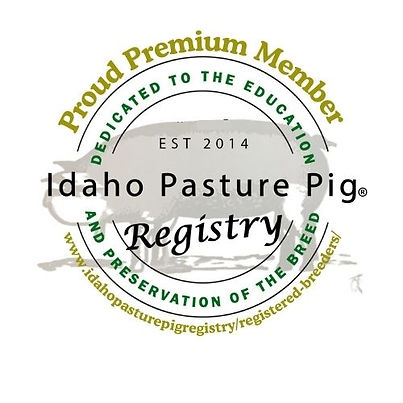Our Pigs
We breed Idaho Pasture Pigs. We feed our pigs grain from the mill EPL. It is a 19.5% hog grower feed that is non GMO, corn free, and soy free! Milly just had her litter on 8/5/25. We are anticipating a possible litter from Scarlett in mid to late December 2025.

Our Breeding Pigs





%20(1).jpg)
Ethically Raising Pigs on Pasture

Why Raising Ethically is So Important
Studies vary, but pigs in general have been shown to possess an intelligence that is superior to that of dogs, possibly as high as a 4th grader. Simply put, this puts the onus on human beings to do better. California's Proposition 12 is a step in the right direction, but it doesn't go far enough.
A System of Abuse
Pigs are social creatures. They are also very clean animals, keeping their bedding and food areas clean when allowed to do so. Traditional factory farming confines pigs to small crates, forcing them to lay or stand in filth as it falls through slats in the floor.
They aren't able to socialize with other pigs, and they are often subjected to unnecessary procedures such as ear notching, tail docking, and tooth nipping. They often end up suffering from various illnesses due to living in filthy, close quarters.


Gestation
Pigs raised in the industrial farming system live horrific lives. Sows spend most of their time living in gestation grates where they can lay down but not turn around. A pig's gestation is 4 months.
Farrowing
Sows are moved to farrowing crates for the birth where they are forced to live laying on their side so the babies can nurse, but the sow cannot move or roll over and accidentally squish her babies. Babies are weaned as soon as possible, often at 2-3 weeks of age.
After weaning the sow is sent to be re-bred and the cycle repeats until she is no longer useful and slaughtered, usually around 3-4 years old.


A Better Way
Here at Lothal Valley Farm, our pigs live on pasture. Piglets live with their mother until weaning, usually sometime between 6-8 weeks of age. We separate mom from her piglets once she's started to become tired of them, laying on her teats to prevent nursing. We then move her to an adjacent pen so she can live her best sow life and dry up her milk. She keeps a watchful eye on her babies but definitely enjoys the much needed break to recover.
Real Living
The babies learn to graze pasture and wallow in mud, root around in the dirt, and live their best pig lives until they reach slaughter weight at about 10 to 11 months old.
We rotate them through our pasture to ensure better health of the pigs and the pasture. With good husbandry you can reduce or eliminate the need for antibiotics and deworming. If a pig has worms, we will worm it. If a pig is sick, we will vet it. We let our sows live longer than the industrial system. We let health, quality of life, litter parity, and farrowing ease determine retirement age.


Loved Until the End
At 10 to 11 months old a mobile slaughter company will come to our farm and process the now adult pigs. The pigs then are transported to our butcher to be cut and wrapped for consumption.
We love each and every one of our pigs. We feed them treats and give them belly rubs. Slaughter day is hard for us. We're there at the beginning helping to deliver them, and we will be there at the end to make sure their last day is a non stressful one.








